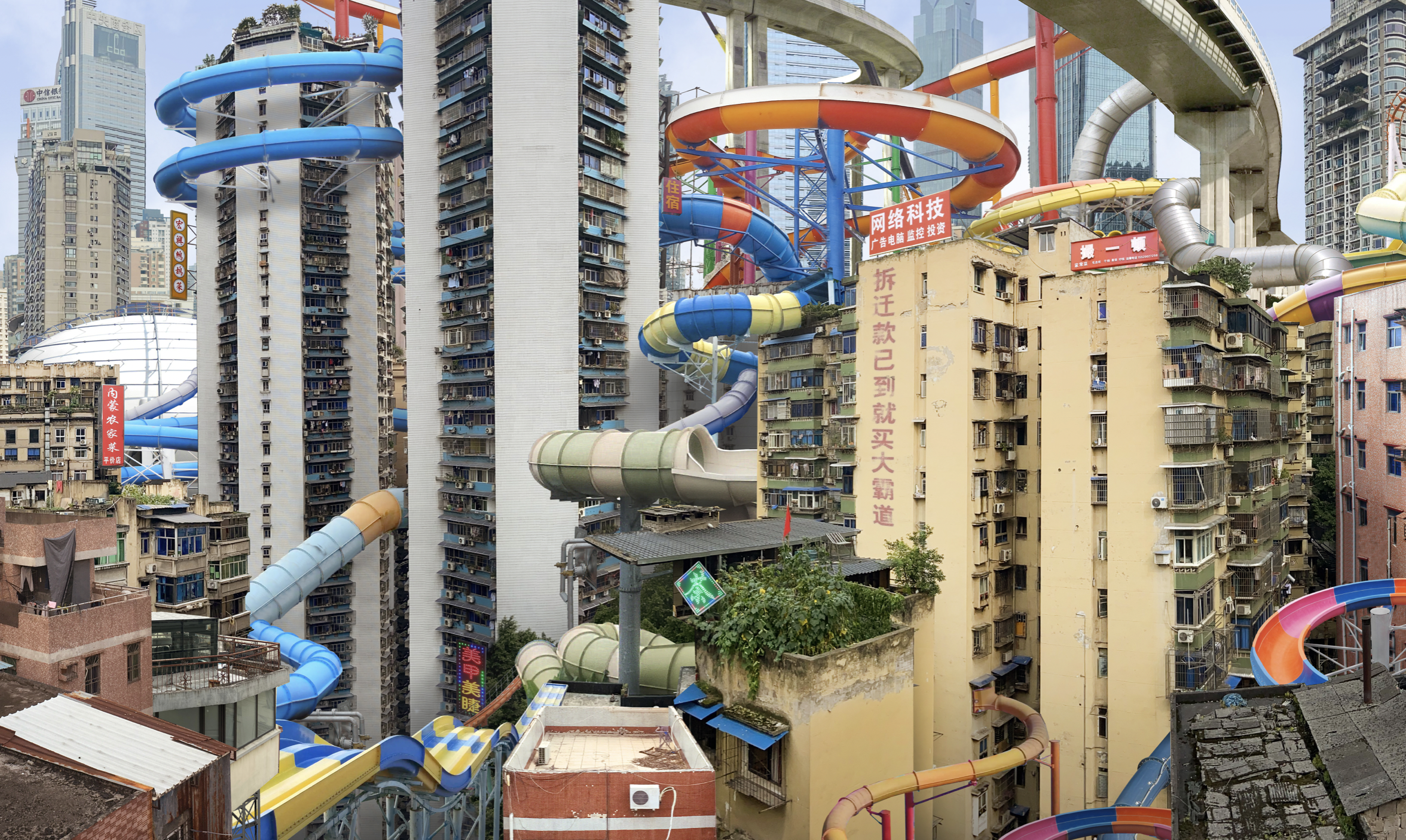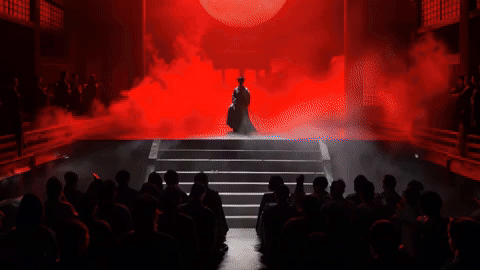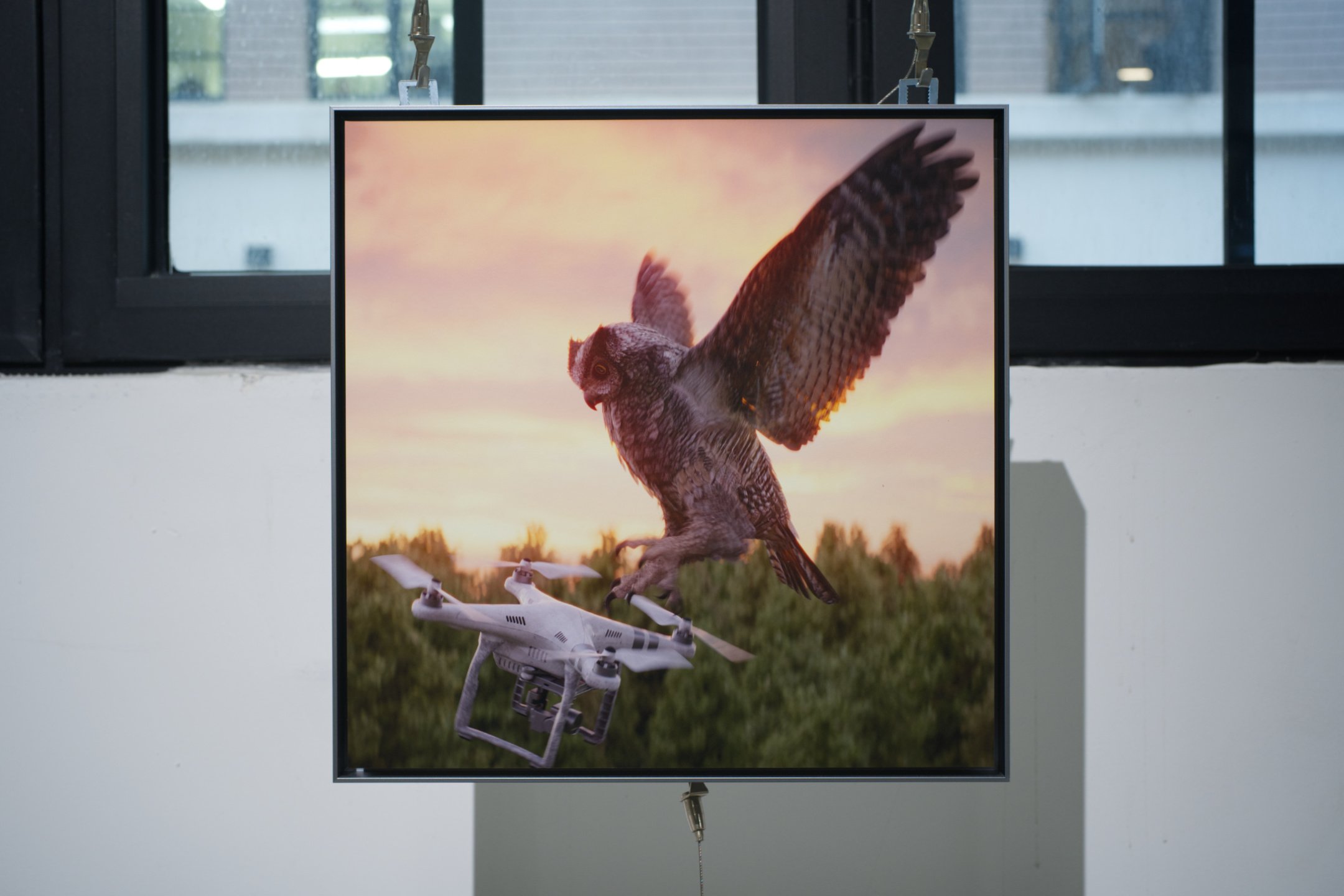China’s Digital Renaissance is a series exploring new currents in Chinese contemporary art, created in partnership with East West Bank. In this article, we explore the value of immersive digital art shows.
It can take hours or even days to fully experience a traditional museum, moving from gallery to gallery, one painting to the next. But on Shanghai’s North Bund, viewers lay out on soft carpeting as they’re guided through a 70-minute audiovisual journey encompassing hundreds of classical paintings, ranging from Renaissance works and Japanese ukiyo-e prints, to masterpieces from modern artists.
“The visuals are quite impactful. I was especially struck by the vibrant color,” said Amor, a high schooler studying art in Shanghai.

This is Amor’s first time seeing an exhibition made up entirely of visual projections. Immersive exhibitions and light shows like this are relatively new in China, having caught on quickly in recent years, especially as Covid impacted museums’ ability to loan artworks from abroad. Now though, some are questioning the value of an exhibition with no authentic works.
History and Rise in Popularity
Immersive exhibitions first gained popularity in China around 2015 when a series of Van Gogh experiences toured major cities like Shanghai and Beijing. The exhibitions aimed to bring the post-impressionist artist’s work to life – with modern technology, audiences could now see strokes being drawn on the canvas, or golden fields of wheat swaying in the breeze.

Since many of Van Gogh’s most famous pieces remain securely housed in Amsterdam, the touring multimedia exhibition offered a new way for audiences to experience the artist’s work.
Fan-favorites like sunflowers, self-portraits, and The Starry Night were made larger-than-life and projected onto gallery walls. An audio guide provided an extra layer to the exhibition, walking audiences through Van Gogh’s life story. One exhibition designed by the Van Gogh Museum in the Netherlands even meticulously recreated the artist’s bedroom, offering a peek into his daily life and routine.

Since then, more players have arrived on the scene, hoping to bring international immersive exhibitions to China’s promising market. One notable example is TeamLab, founded in Japan and known for its borderless and futuristic approach to art. TeamLab began rolling out shows in cities across China, eventually establishing three permanent exhibitions in Beijing, Shanghai, and Macau.
Several other immersive digital art shows followed the formula of the Van Gogh exhibition, bringing audiences into the worlds of famous artists like Claude Monet and Leonardo da Vinci through digital projection, or through virtual and augmented reality.
In 2019, recognizing that international companies were dominating the space, Sharon Xu and partners established Temple of Light, a Shanghai-based company catering specifically to Chinese audiences.
“Immersive digital art exhibitions are still a relatively new concept for the consumer market,” said Xu. “I believe that it will definitely be a major trend in the future.”
Where’s the Value?
Now though, as some of the initial novelty around immersive exhibitions begins to wear off, many are starting to question the appeal of an all-digital show without any authentic artwork. Some have taken to social media to voice complaints about shows not living up to the hype.

For curators, conveying the value of an ‘art experience’ has always been a challenge.
“Providing value for an audience with only digital projections of artwork can be a challenging aspect for us,” said Xu. “Some viewers might perceive it as just a PowerPoint presentation.”
Over the years, the standard for equipment used by immersive shows has increased. Higher-end projectors, speakers, and VR headsets all lead to a more vibrant and immersive exhibition, especially for new audiences who are chiefly concerned with the overall experience.

Linda Zhou, a freshman at Duke Kunshan University, went to see an immersive Monet exhibition that her art-major friend had recommended.
“I actually don’t know much about paintings,” says Zhou. “I was just there to experience the atmosphere and have some fun.”
She was especially impressed by the show’s virtual reality aspects, and by the visual projection of Monet’s life story. During the hour Zhou spent in the exhibition room, she ended up learning more than she had expected about the impressionist painter.
“I can just sit quietly in my seat and listen to the first-person narrative. There’s a detailed narration, telling the story of Monet’s birth, his departure from his hometown, and the later years of his life,” Zhou recalled.
“After watching it, I can understand why Monet created the work he did.”

As someone who didn’t know much about the art world, Zhou found herself preferring the immersive style of the show over a traditional exhibition, as it offered more context and explanation for the uninitiated.
Her friend, however, still prefers exhibitions with authentic paintings, where she can admire each brushstroke up close. She says that appreciating the real, in-person color and feel of an artwork is more important to her.
Xu feels that each style of art exhibition has its place. Rather than replacing or battling against traditional galleries, immersive shows offer a different experience for the general public.
“Compared to traditional exhibitions, I feel that digital exhibitions are more accessible, and have a lower barrier to entry, making them more inclusive for the public,” she explains.
Yvette Wang, co-founder of a Shanghai art gallery Cub_ism_ Artspace echoed Xu’s idea, pointing out that traditional art exhibitions and immersive shows are actually two very different fields.
“Gallery exhibitions primarily serve the artworks, presenting the paintings in the best possible way. On the other hand, immersive exhibitions encourage more audience interaction,” she said.
“If the idea is solid, it can open up new ways to experience the art. Ultimately, it depends on how well the exhibition is prepared.”
Xu also endorsed the importance of curatorial vision when organizing an immersive art exhibition.
“Anyone can make a movie, but it’s the director who ultimately tells the story. I believe that even with the same script, different directors can present different interpretations, even in the same studio using the same equipment,” said Xu. “It all comes down to creativity.”
Today, Temple of Light has welcomed over 200,000 visitors to their permanent galleries in Shanghai and Shenzhen despite pandemic disruptions.
“Our vision is actually to popularize art and encourage more people to appreciate it. Perhaps, after experiencing our digital exhibition on the Renaissance, for example, they might be more willing to visit a museum when there is an exhibition of authentic artworks,” said Xu.
Controversy Over Commercialization
The commercial success of some immersive shows has drawn criticism, particularly over the idea of companies cashing in on the concept while dodging the costs associated with traditional art.
Immersive shows in China are usually priced around 100 – 300 RMB (about 15 to 45 USD), similar to traditional art exhibitions at major museums.
“It is a bit overpriced, to be honest,” said Amor, even though she enjoyed the Temple of Light exhibition.
Xu points out though, that a well-produced immersive exhibition is no cheaper to organize than a traditional one. Although digital art doesn’t come with the same shipping, insurance, and security costs associated with displaying a physical Van Gogh painting, for instance, the space and equipment required aren’t cheap either.

“Actually, in the initial stages of organizing digital exhibitions, there was no significant advantage in terms of funding required,” Xu said.
However, after a show is up and running, the costs go way down – Xu pointed out that once the content is created, it’s possible to showcase an exhibition in different cities or countries simultaneously.
Art Show or Photo Op?
If you attend one of these immersive shows, you’ll immediately notice the number of people taking photos.
The visually striking nature of these exhibitions seems to strike a chord with influencers. Some exhibitions, including the Temple of Light, have advertised themselves as a “good place to take photos.”
Amidst the flood of selfies and social media posts, some are wondering whether the events are meant to showcase art or offer a photo op.
“From my perspective, I don’t think one reason for coming to the show is better than another,” said Xu. “Whether it’s purely to appreciate the art or also to check in on social media – I believe both kinds of audience can coexist.”

For event organizers, social posts are an effective, organic way to gain some publicity and raise awareness. Xu and her team are trying to strike a balance, encouraging audiences to spread the word while hoping they leave the exhibit with more than just some nice pictures.
“I don’t want our exhibition to turn into just another photo op,” she says. “I hope that throughout this process, we can contribute at least a little to public art education, and play a positive role.”
For Amor the high school art student, if selfie-snappers don’t get in her way, she doesn’t mind having them there.
“As long as the actual value of the show remains the same, it doesn’t matter to me if people come to take pictures,” she said. “If it can get more people to appreciate art, I’d say that’s a good thing.”
The Future
We can’t stop the tides of change, and emerging tech like AI is already seeping into every industry, including the art world. Facing a rapidly-transforming world, more and more galleries are starting to incorporate digital art.
Wang, the 26-year-old gallery owner, believes it’s a good thing for audiences to have more options to choose from.
“I myself might attend an immersive show from time to time, some of them are pretty well done,” she confessed. “It would be better not to compare them too closely with traditional exhibitions – they’re fundamentally different.”

Xu, meanwhile, is optimistic about the future of her own team’s immersive exhibitions. While most immersive exhibitions so far have focused on famous Western artists, as a Chinese company based in Shanghai, Temple of Light has plans to create more shows based on traditional Chinese art and culture.
She cites a recent immersive exhibition on the ancient murals of Dunhuang as one example of a show that features aspects of Chinese culture within the new, technology-driven format.

“I hope that we can eventually bring our own digital exhibitions of Chinese art to other countries around the world,” said Xu. “And that global audiences will have the chance to see and understand Chinese culture from a different artistic perspective.”
Cover image via Temple of Light
















